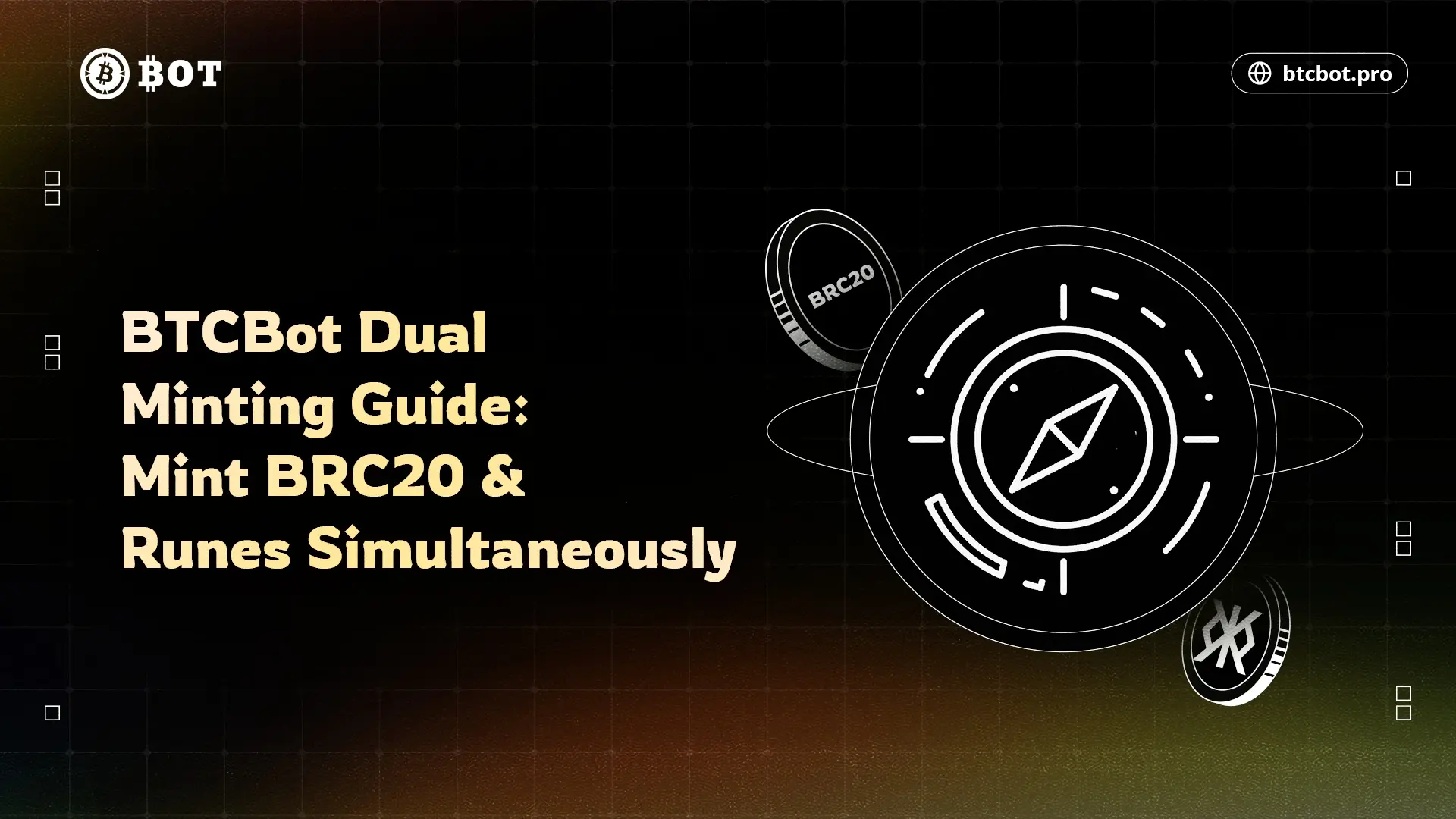80% of the income comes from token trading taxes and security concerns. How long will the Unibot narrative last?
Author: Grapefruit, ChainCatcher
Recently, information related to Unibot, such as "Daily capture fees reach $665,000, UNIBOT token increases about 50 times in two months," has been circulating in various crypto communities.
According to DeFiLlama data, on July 24, Unibot captured a revenue of up to $665,000 within 24 hours, while Uniswap's revenue during the same period was $983,000.
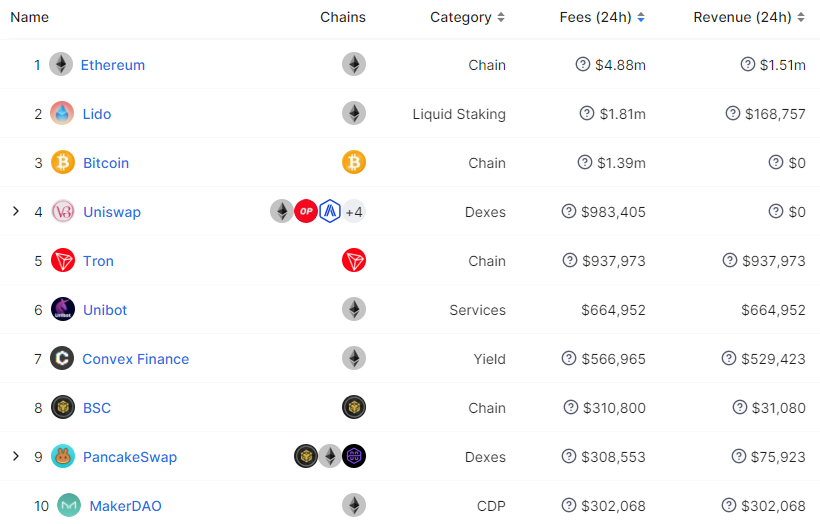
Coingecko shows that its token UNIBOT rose from $3 on May 22 to a peak of $148, an increase of about 50 times, and is currently priced at $138.
Unibot's outstanding performance has sparked a wave of speculation in the crypto industry regarding bot trading projects, leading to a surge of various trading bot projects on Telegram, Discord, etc., with their tokens experiencing several-fold increases in a short period. For instance, the bot Loot Bot, which helps users claim airdrops, saw its token LOOT rise by as much as 4 times in a single day.
Regarding the rapid explosion of the Bot project sector, some people are optimistic, while others observe rationally.
Optimistic users believe that Unibot allows users to complete on-chain token trades on social software like Telegram, significantly lowering the barrier for users to engage in on-chain activities. Currently, more optimism stems from the fact that Unibot's captured revenue has surpassed that of most leading DeFi protocols. Meanwhile, neutral users argue that Unibot-like projects are easily replicable, and a mix of quality will emerge in a short time, raising concerns about security.
How long will this narrative around Unibot last? Will Unibot fade away quickly like memecoins, leaving chaos in its wake after the hype?
Additionally, data shows that over 80% of Unibot's captured fees actually come from transaction taxes on the native token UNIBOT (users need to pay a 5% transaction tax for each UNIBOT token transaction), with less than 20% of the revenue coming from its claimed trading fees. Furthermore, the trading pairs completed by Unibot's trading bot are mostly memecoins. In the Unibot trading competition held in July, over 65% of the more than 1,000 participating on-chain addresses were in a state of loss.
UNIBOT Token Soars, Revenue Surge Sparks Speculation in Telegram Bot Sector
According to Dune@whale_hunter data, since its launch in May, Unibot has captured a total revenue of 3,280 ETH, worth $6.08 million, completing a total trading volume of $85.76 million. Its token UNIBOT surged from $3 in May to a peak of $148 on July 24, an increase of about 50 times.
The total issuance of UNIBOT is 1 million, currently priced at $109, with a market cap of $130 million.
As a new application, Unibot has exceeded $6 million in revenue within just two months, with the UNIBOT token increasing by about 10 times. The rapid surge in revenue and token price has successfully attracted attention to the Telegram Bot sector and sparked speculation.
Last week, exchanges like Huobi and Bitget listed the UNIBOT token, and crypto data platforms like CoinGecko and CoinMarketCap also launched tokens in the Telegram Bot sector.
Among them, CoinGecko co-founder Bobby Ong has repeatedly posted about Telegram Bot-related content on Twitter. He stated that the biggest pain point for new users entering the crypto industry is the difficulty of using wallets and DeFi protocols. After experiencing Unibot, he believes he has a sense of how the next wave of billions of new users will interact with cryptocurrencies. The idea behind Unibot is simple—build a fast and easy wallet on Telegram and integrate it closely with DEX, making DeFi trading much easier on mobile.
In another tweet, he wrote that Telegram Bot tokens represented by Unibot will become the next crypto hotspot in the next 1-2 months and asked users if they agree.
What exactly is Unibot? What are its features?
Unibot is a trading tool bot built into Telegram, allowing users to issue trading instructions to the bot in a conversational format to complete on-chain token transactions on Uniswap, such as token swaps, copy trading, limit orders, and private transactions. Additionally, Unibot provides real-time alerts for new Ethereum tokens, enabling users to easily add tokens and execute sniper trades, charging a fee of 0.5% to 1.5% for each transaction.
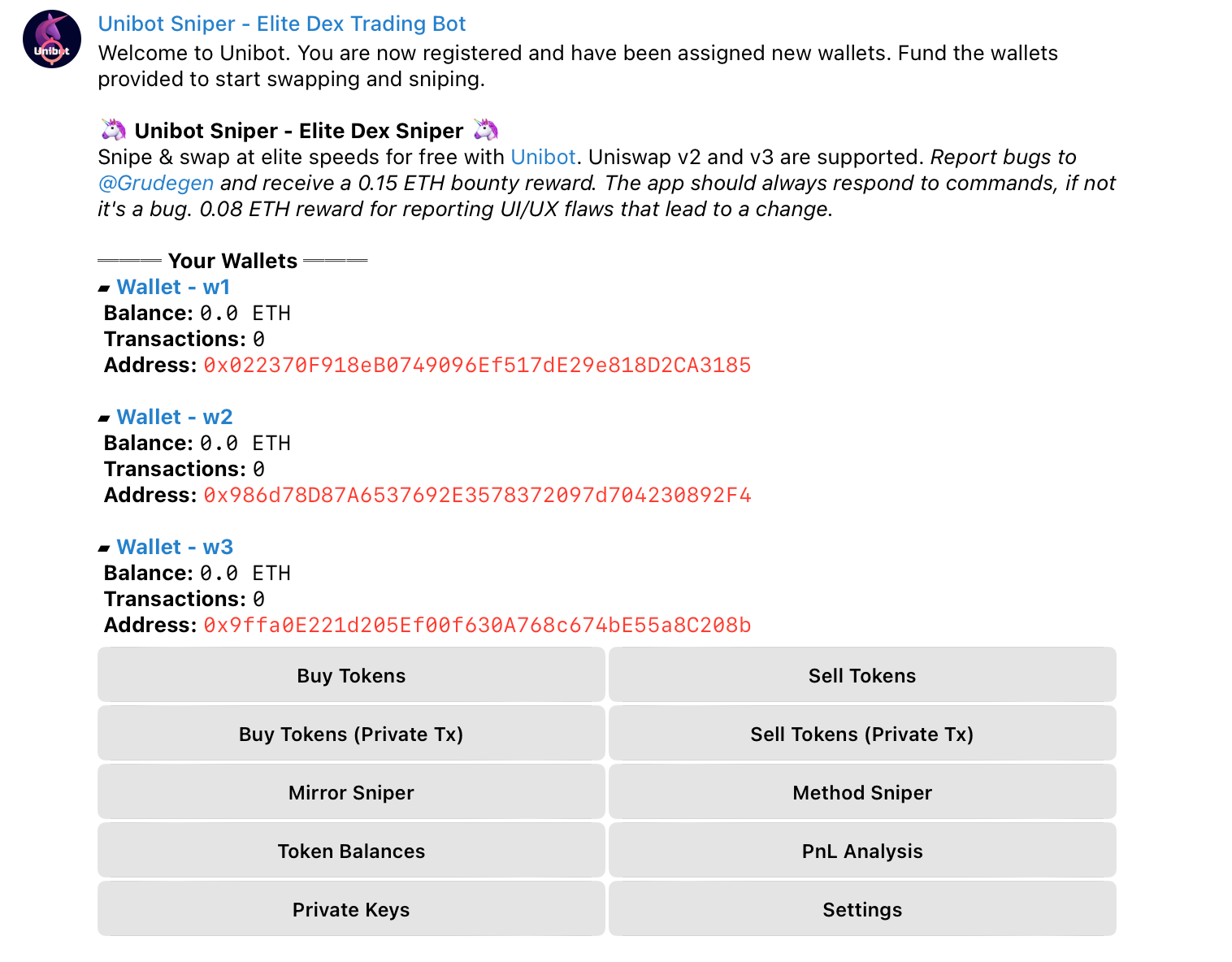
From this perspective, Unibot provides convenience for users' on-chain trading, allowing token swaps without leaving the Telegram social software, thus reducing the barrier for users. Moreover, as a well-known social application, Telegram is expected to gain 300 million new users globally by the end of this year, bringing more users into the crypto world.
The emergence of Unibot has made Telegram Bot a separate crypto sector. So, what are the representative projects in the Telegram Bot sector?
According to CoinGecko, as of July 26, the total market cap of the Telegram Bot sector is $161 million, with a 24-hour trading volume of $22.65 million.
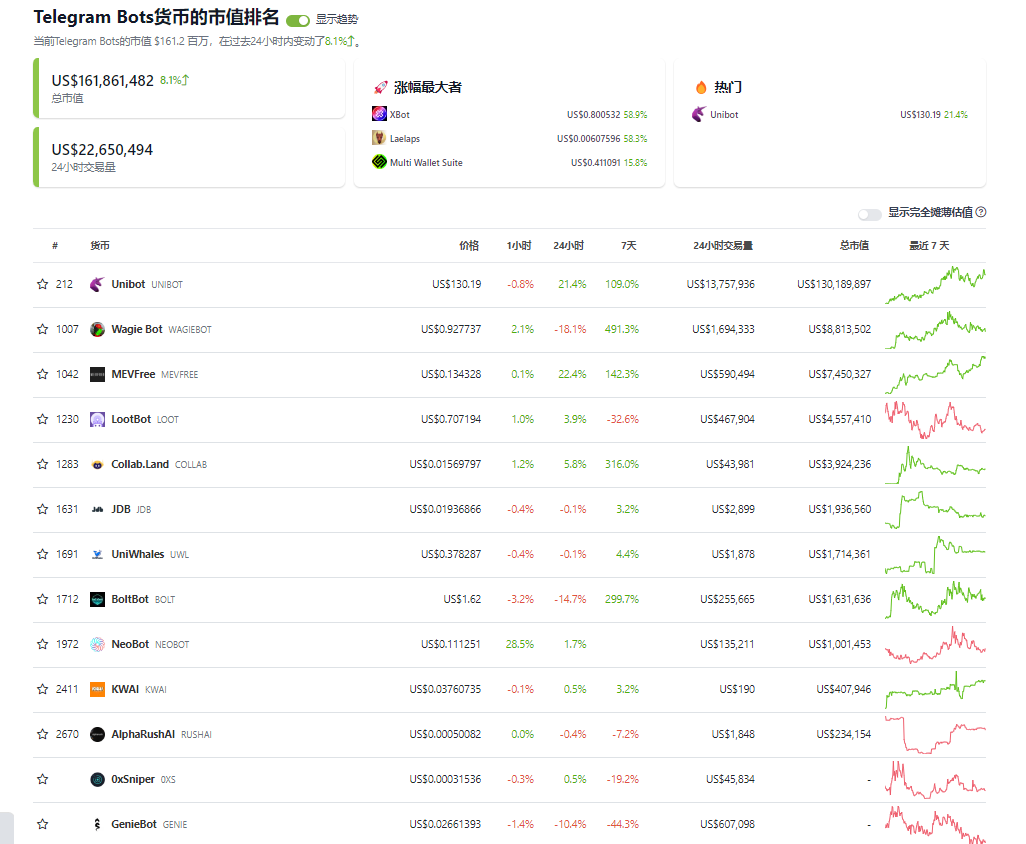
Representative projects:
LootBot--- is a bot that helps users complete automated airdrop interactions on Telegram, aimed at automating airdrop harvesting. It automates airdrop interactions across multiple EVM-compatible chains, tracks airdrop claim progress, and prevents witch attacks.
Bolt Bot---a Telegram trading bot that categorizes subscription levels based on the number of BOLT tokens held by users, with different levels supporting different functionalities (higher levels support whale watching, presale sniping, etc.), and varying trading fees.
SwipeBot --- a Telegram trading bot for ETH, ARB, and BSC chains. Users must hold 500 SWIPE tokens to access SwipeBot; if the amount held is below 500 SWIPE, a 0.5% trading fee will be charged, and it opens to non-holders once every two weeks.
MEVFree --- a Telegram trading bot that prevents MEV attacks, helping users avoid being sandwiched during trades.
0xSniper --- a DeFi trading bot that aims to meet the needs of both experienced and novice traders, providing a navigation platform.
Unibot's Revenue 80% Comes from Token Trading Tax, Security Concerns
Telegram Bots provide users with a simple and friendly way to trade cryptocurrencies. Currently, based on user experience, token trends, and captured revenue, Unibot appears to be a successful product. However, over 80% of Unibot's captured revenue comes from transaction taxes on the native token UNIBOT, and the majority of transactions completed on the platform are also memecoins. Since token trading taxes and the popularity of memecoins are not sustainable, will Unibot's narrative fade like memecoins?
According to Dune data, of the 3,280 ETH revenue captured by Unibot, 2,843 ETH comes from UNIBOT token trading taxes, while revenue from bot trading activities is only 437.2 ETH (about $810,000). In other words, over 80% of Unibot's revenue comes from UNIBOT token trading taxes, with less than 20% from the core bot trading business.
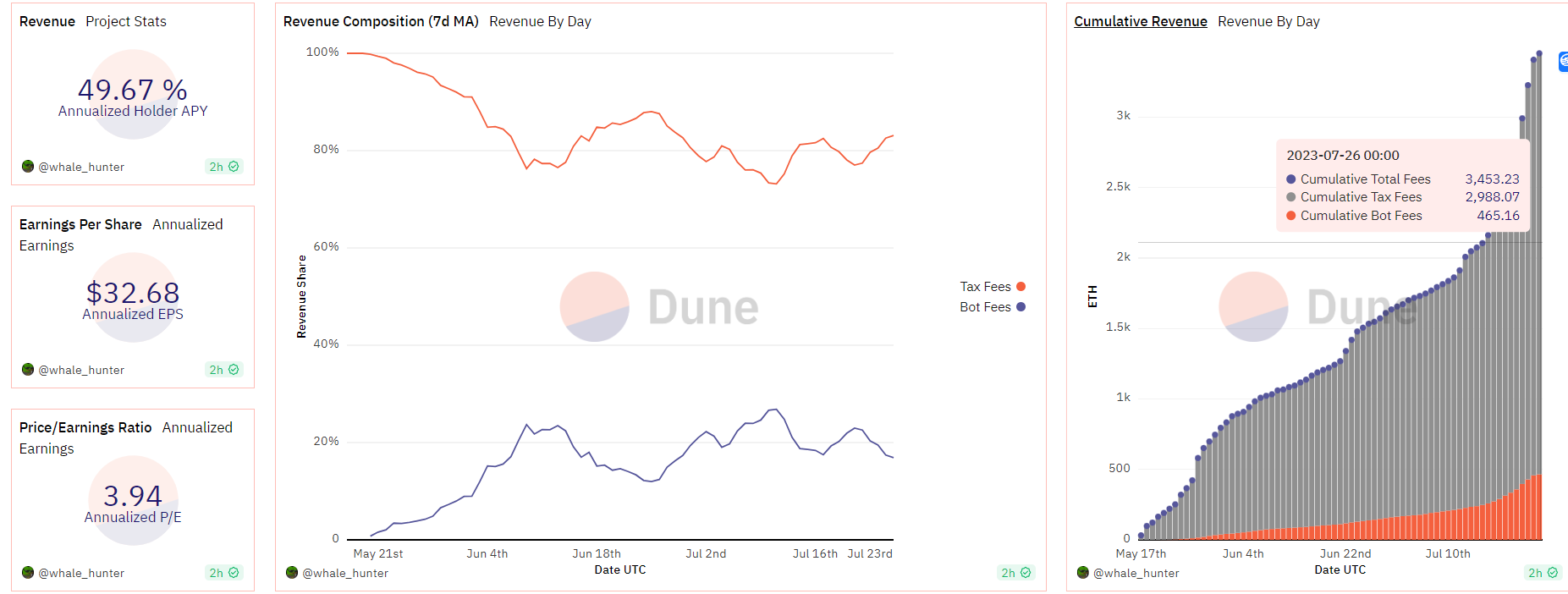
Currently, Unibot generates revenue mainly through two methods: bot trading fees (Bot Fee) and transaction taxes on the native token UNIBOT. For the former, Unibot charges a 1% fee on each transaction, with 40% allocated to token holders; the latter refers to the 5% tax on all UNIBOT token transactions, with 1% of the trading volume distributed to token holders, and token holders must have a balance of more than 50 UNIBOT to qualify for revenue-sharing rewards.
In simple terms, if a user holds more than 50 UNIBOT tokens, they can receive 40% of the trading fee and 1% of the UNIBOT trading volume tax revenue.
The trading tax mechanism is commonly seen in meme tokens, such as the AIDOGE token on Arbitrum, which has a 15% trading burn tax mechanism, similar to NFT royalty mechanisms. This mechanism is often considered designed to reward long-term holders to reduce token sell-offs. However, this also means that users incur losses upon buying. For instance, with a 5% trading tax on UNIBOT, users lose 10% upon purchase, as they must pay 5% to buy and another 5% to sell. Therefore, the sustainability of tokens relying on trading tax dividends is uncertain, and currently, no mainstream crypto projects incorporate trading taxes, with even NFT royalty competition trending towards zero.
Moreover, most of the trading volume completed by Unibot mainly relies on its own token UNIBOT-WETH. The most traded tokens are memecoins, with the third-ranking being the on-chain hamster racing game token HAMS, followed by the ape-themed token JIM. If the popularity of memecoins wanes, how will Unibot maintain its trading volume?

In the trading competition held by Unibot in July, about 1,402 users participated, but over 65.2% of the trading addresses were actually in a state of loss.
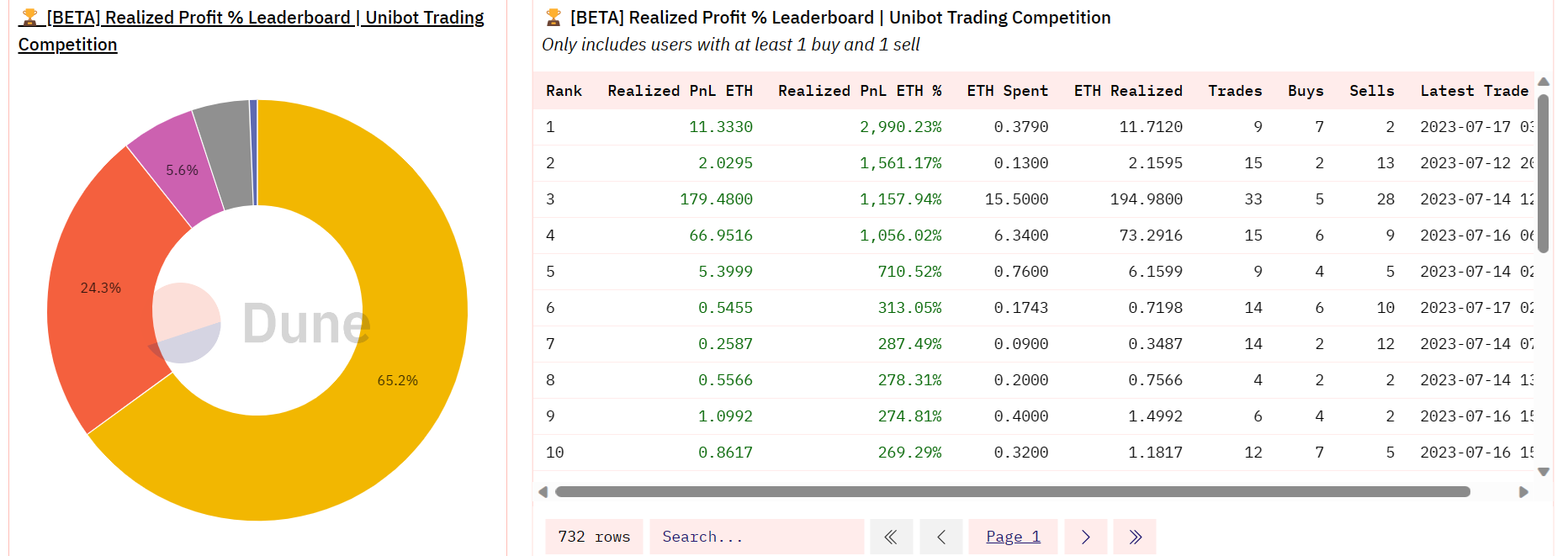
In fact, Unibot's trading volume has significantly declined, with only $1.1 million in trading volume on July 26 and captured fees of $22,000.
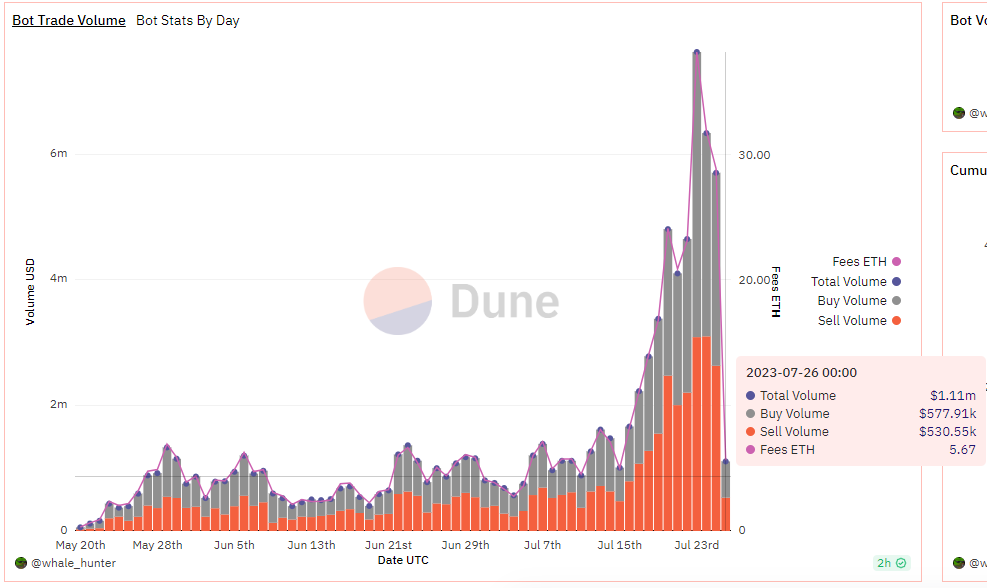
In addition to the sustainability issues of the business, Unibot's security has also been questioned by users. During the use of Unibot, the bot automatically generates new wallet addresses, and users need to deposit corresponding assets to execute purchases. However, the private keys for these three wallets can be queried on the Telegram page, meaning that if a Telegram account is hacked, the assets in the addresses could also be stolen. Additionally, users face the risk of leaking their wallet private keys when importing them into Telegram, and there is a possibility of making mistakes when entering token addresses for purchases.
Regarding security, CoinGecko co-founder Bobby Ong once stated, "I would never put a large amount of assets on any bot. If a bot stores its users' private keys and deceives them by transferring assets to its own wallet, I would not be surprised at all."
Therefore, users need to be aware of the risks when using Unibot and similar bots, and it is advisable to invest only a small amount of funds and use a new wallet.












